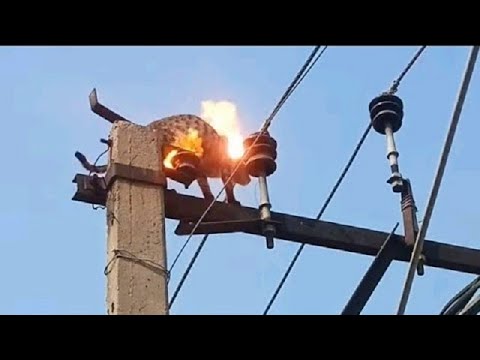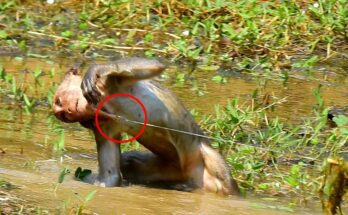In a tragic yet eye-opening incident that unfolded in a quiet town on the outskirts of the city, a monkey was electrocuted after coming into contact with a high-voltage power line. The event has sparked a wave of concern among both wildlife enthusiasts and local authorities about the increasing frequency of such encounters between animals and urban infrastructure.
The monkey, believed to be a member of a local troop that frequently roams the area in search of food, had climbed atop a transformer located on a utility pole. Witnesses say the animal appeared to be curious and playful, as is typical of its kind, swinging from cables and perching on insulators. However, in a split second, the situation turned fatal. The monkey made contact with an exposed live wire, resulting in a powerful electric shock that sent a loud pop through the neighborhood and caused momentary power disruption.
Residents rushed out to see what had happened, only to find the monkey’s motionless body draped across the structure. Electricity officials were soon called to the scene to cut off power and safely remove the animal. While the incident was deeply saddening, it also raised important questions about how such accidents can be prevented in the future.
Experts say incidents like these are becoming increasingly common as natural habitats shrink and wild animals venture into human settlements. Urban areas, with their abundance of food waste and shelter, often attract monkeys, birds, and other wildlife. But the modern infrastructure — particularly electrical systems — poses a significant threat. Power lines, transformers, and substations are not designed with animal safety in mind, leading to fatal consequences when creatures interact with them.
Wildlife conservationists argue that it’s not only a loss of life but also a reminder of how urban expansion and deforestation are disrupting the natural balance. “The monkey was simply doing what came naturally — exploring and adapting to its environment,” said one local environmentalist. “But the environment has changed drastically, and now it’s filled with dangers they’re not equipped to understand.”
Local utility companies have responded to the incident by stating that they are working on implementing more animal-friendly electrical infrastructure. Some measures being considered include insulating power lines, placing barriers on transformers, and installing warning signs in high-risk areas. Additionally, animal rescue groups are encouraging local residents to avoid feeding or encouraging monkeys near residential areas, which can increase their reliance on human settlements.
While the story of the monkey who got electrocuted may seem like just another unfortunate accident, it highlights a deeper conflict between nature and human development. It serves as a poignant reminder that as we continue to expand our cities, we must also find ways to coexist with the wildlife that once freely roamed the very land we now occupy.



